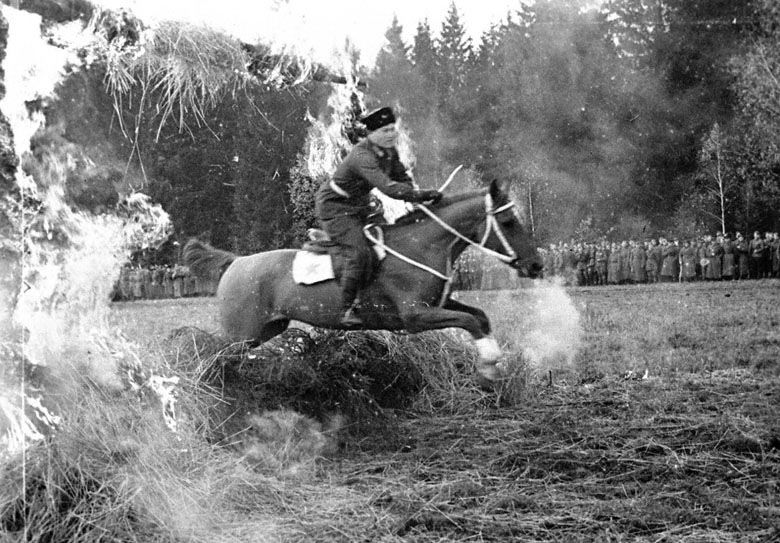Post by horsesoldier176 on Apr 17, 2009 13:58:53 GMT -5
Lend-lease: Aircraft Deliveries to the Soviet Union
By Carl-Fredrik Geust
(Reprinted from Red Stars 4 with kind permission from the author)
Although USA was still not at war with Germany, 11 March 1941 the American Congress adopted the so-called Lend-lease act which envisaged lending or leasing arm and ammunition, provisions and other material to nations in a state of war with the states of the Nazi bloc, thus per definition the prime beneficiary was Great Britain.
Immediately after the German attack on the Soviet Union 22 June 1941 the British Prime- Minister Churchill promised British assistance to USSR. A British credit line was subsequently opened 16 August 1941, and arms deliveries from England were immediately initiated with the American Lend-lease principles as guidelines. (The British Lend-lease to the Soviet Union was formalized in a British-Soviet agreement signed only 26 June 1942.)
24 June 1941 Soviet assets in American banks (which had been frozen after the Soviet attack on Finland 30 November 1939) were released by President Roosevelt, which enabled the
Soviets to immediately purchase 59 fighters (including at least 21 P-40s). Negotiations concerning application of the Lend-lease act were simultaneously initiated.
A high-level Soviet aviation commission led by Maj.Gen. and Director of LII M.M.Gromov (and including the famous test-pilots G. F. Bajdukov, A.B .Yumashev etc.) was dispatched to USA in late August 1941. Gromov's delegation made a daring trip along the future ALSIB-route through Siberia to Alaska in two GST-flying boats, and then investigated and studied tested various American combat aircraft at several USAAF bases. The Soviet delegation was prepared to fly home with a number of Boeing B-17s, which was absolutely refused by the Americans (Gromov attempted even a direct appeal to President Roosevelt whom he had met after his non-stop ANT-25 flight from Moscow to San Jacinto, California in July 1937). After rejection of the Martin B-26 proposed by the Americans the Russians settled for five B-25 Mitchell bombers which were delivered by ship to Murmansk in late 1941. An interesting point is that Sikorski R-4 helicopters offered to another Soviet delegation were also refused by the Russians.
After return of Gromov's partly unsuccessful Soviet delegation the first US-Soviet Lend-lease protocol was signed in Moscow 1 October 1941. As President Roosevelt declared the defense of Russia vital to USA the Lend-lease act was formally extended to USSR on November 1941.
American Lend-lease to the Soviet Union can be divided into the following phases:
- "pre Lend-lease" 22 June 1941 to 30 September 1941
- first protocol period from 1 October 1941 to 30 June 1942 (signed 1 October 1941)
- second protocol period from 1 July 1942 to 30 June 1943 (signed 6 October 1942)
- third protocol period from 1 July 1943 to 30 June 1944 (signed 19 October 1943)
- fourth protocol period from 1 July 1944, (signed 17 April 1945), formally ended 12 May 1945 but deliveries continued for the duration of the war with Japan (which the Soviet Union entered only 8 August 1945) under the "Milepost" agreement until 2 September 1945 when Japan capitulated. 20 September 1945 all Lend-Lease to Russia was terminated.
In addition to the aircraft deliveries American Lend-lease deliveries to Russia included also more than 400.000 trucks, over 12.000 tanks and other combat vehicles, 32.000 motorcycles, 13.000 locomotives and railway cars, 8.000 anti-aircraft cannons and machine-guns, 135.000 submachine guns, 300.000 tons of explosives, 40.000 field radios, some 400 radar systems, 400.000 metal cutting machine tools, several million tons of foodstuff, steel, other metals, oil and gasoline, chemicals etc. A price tag was naturally attached to all deliveries, with following typical fighter prices:
P-40 Kittyhawk - 44.900 dollars, P-39 Airacobra - 50.700 dollars and P-47 Thunderbolt - 83.000 dollars.
Regardless of Soviet cold-war attempts to forget (or at least diminish) the importance of Lend-lease, the total impact of the Lend-Lease shipment for the Soviet war effort and entire national economy can only be characterized as both dramatic and of decisive importance. The outcome of the war on the East front might well have taken another path without Lend-lease. There were undoubtedly big difficulties in the early period: aircraft modified for tropical conditions were delivered to Arctic ports, Russian-language instructions were lacking, a big number of aircraft were grounded because of lack of spares, ammunition, bombs or high-octane fuel. Soon many technical problems 'were overcome, Soviet guns and bomb racks were installed, and numerous other technical improvisations were made in Soviet AF frontal units. Soviet specialists developed also ingenious technical improvements and modifications of the original aircraft versions. In parallel the new American technology was systematically investigated in research and design institutes, and the total impact for the modernization of the Soviet aviation industry was certainly immense. The ultimate peak of this learning process was the post-war copying of the Boeing B-29 in only two years time, resulting in the Soviet nuclear-bomb carrier Tu-4.
Lend-lease aircraft amounted to 18% of all aircraft in the Soviet air forces, 20% of all bombers, and 16-23% of all fighters (numbers vary depending on calculation methods), and 29% of all naval aircraft. In some AF commands and fronts the proportion of Lend-Lease aircraft was even higher: of the 9.888 fighters delivered to the air defense (PVO) fighter units in 1941-45 6.953 (or over 70%!) were British or American. In the AF of the Karelian front lend-lease aircraft amounted to about two-thirds of all combat aircraft in 1942-43, practically all torpedo bombers of the naval air forces were A-20G Bostons in 1944-45 etc.
Some American aircraft types were simply irreplaceable and very highly appreciated on all levels during the war, e.g. P-39 Airacobra fighters, A-20 Boston and B-25 Mitchell bombers and C-47 transport aircraft.
Several Soviet aces scored more than 40 victories with Airacobras. G.A.Rechkalov' s 50 victories are apparently the highest score ever with an American fighter, while the No.2 Soviet ace A.I.Pokryshkin claimed 48 of his 59 victories when flying Airacobras.
Initially the main Lend-lease route was by ship to Murmansk and Arkhangelsk in northern Russia. In 1942 two other supply routes were opened: a southern route via Iran (where the aircraft are assembled and flown into the southern part of the Soviet Union), and above all the ALSIB (Alaska-Siberia) route which was opened on 29 September 1942. The aircraft were flown by American crews to Fairbanks, Alaska, where they were handed over to a Soviet commission headed by Col. M.G.Machin, and ferried to Krasnoyarsk in Siberia by specially selected Soviet pilots of 1 PAD (ferry aviation division) commanded by Arctic veteran-pilot Col. I.P.Mazuruk (HSU 27.6.1937).
1 PAD consisted of five ferry regiments (PAP), each of which was responsible for a certain part of the route:
- 1 PAP - Fairbanks-Uelkal (1.500 km),
- 2 PAP - Uelkal-Seimchan (1.450 km),
- 3 PAP - Seichan-Yakutsk (1.167 kin),
- 4 PAP - Yakutsk-Kirensk (1.331 km),
- 5 PAP - Kirensk-Krasnoyarsk (965 km).
In Krasnoyarsk "ordinary" pilots took over, flying the newly arrived aircraft westwards via Omsk, Sverdlovsk and Kazan to Moscow for further distribution to frontline units. Yakutsk-based 8 TAP was responsible for returning the ALSIB-ferry crews to Fairbanks.
The ALSIB route turned out to be very successful and fast. Regardless of the primitive sub-zero conditions and extremely long distances over the deserted areas losses in transit were surprisingly small: of 8.058 aircraft delivered at US factories 74 were lost in USA, 58 lost in Canada and Alaska, and on the Siberian leg 42 aircraft crashed fatally.
In addition to the mutually planned and agreed lend-lease deliveries a number of additional aircraft of various types were also handed over to Soviet authorities for various reasons (e.g. Hampden torpedo-bombers and PR Spitfires in the Murmansk region, two Liberators stranded in Siberia etc.). A considerable number of American B-17 and B-24 bombers and P-38 and P-51 fighters force-landed in Eastern Europe were also repaired and taken into use by the Soviets (in particular in connection with shuttle-bombing Operation Frantic). In this context it should be mentioned that regardless of repeated requests, the Americans refused to deliver four-engine heavy bombers (B-17, B-24, B-29), four-engine transports (C-54) and night-fighters. Certain instrumentation and avionics (e.g. top-secret and accurate Norden bombsights) were also stripped from the aircraft before delivery to Russia. Nevertheless Norden-bombsights were delivered in quantity in late-model Mitchells in 1945, and PBY-6A and PBN-1 naval aircraft were delivered with American airborne radars (according to some sources US Navy was not aware of the delivery embargo imposed by USAAF!).
According to the lend-lease agreements all weapon systems delivered were to be returned to USA after cessation of hostilities or destroyed under American supervision. A big number of aircraft (also including recent deliveries of P-39s, P-63s and P-47s) were in fact destroyed by bulldozers - much to the amaze of on-looking Soviet soldiers. Many naval vessels were returned to USA in the late 1940s, but a big number of lend-lease aircraft were still in use in Russia in the early 1950s. The unsettled lend-lease accounts are still - after almost 50 years - disturbing American-Russian relations.



